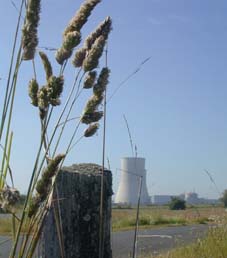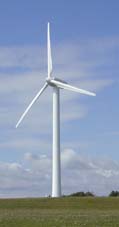|
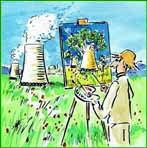
|
EFN -
NEWS
Newsletter of
EFN
Environmentalists
For Nuclear Energy
27th
August 2004
|
This document is archived on
the internet and can be consulted at the following address:
http://www.ecolo.org/archives/archives-nuc-en/
Tchernobyl story on
Discovery Channel
EFN in the headlines
- The Independent does it again

by Bruno Comby
Tchernobyl
story on Discovery Channel on sunday August 29th, 2004
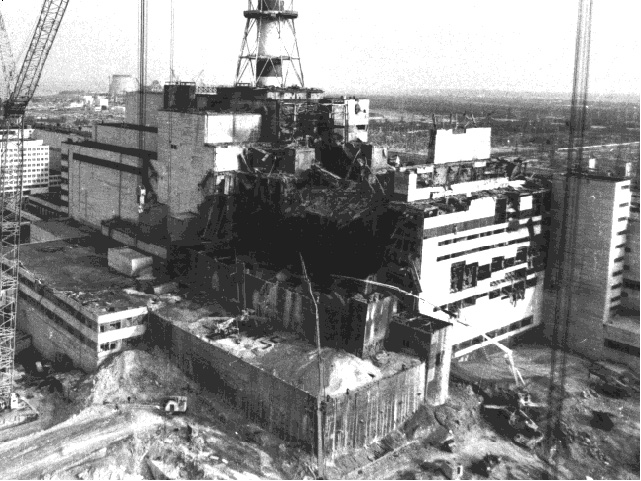 Photo
of the Chernobyl reactor building after the accident
(1986)
Photo
of the Chernobyl reactor building after the accident
(1986)
Dear readers, dear friends,
This is an absolutely unique eye-witness story on
Chernobyl. Of the survivors, Alexander Yuvchenko was among the
nearest to the scene of the accident of 26 April 1986, and certainly
one of the most technically competent to ever speak of his experience
on this occasion. He was an engineer at the Chernobyl power plant, on
duty that night at Reactor Number 4, in an office quite close to the
explosion, living the experience of seeing the injured and giving
first aid, being in the control room and witnessing what happened
there and recording here the first perceptions of the
accident.
According to the extract of his story published on
the internet, this film is a rather spectacular eye-witness account
(see URL below). It is to be broadcast for the first time and will
undoubtedly further traumatize public opinion.
Alexander Yuvchenko will appear in "Disaster at
Chernobyl" on Discovery Channel in Europe at 10pm (UK time) (21H00
UTC/GMT) on sunday 29th August 2004.
This gentleman who was at the wrong place at the
wrong time speaks openly of his experience. As he says at the end of
the interview published on the web (see the New Scientist article
below), he is not anti-nuclear, despite these happenings, provided
that safety is considered as a priority. This is exactly the argument
and position of EFN.
It would be interesting:
1/ to view this documentary, and to try to
understand whether it is true or fanciful,
2/ to secure a copy for EFN's archives,
and
3/ perhaps to contact Alexander Yuvchenko
afterwards, if his story isn't too fanciful, to invite him to become
a member of the Committee of Honorary Members of EFN.
To find out what it's all about, don't miss this
documentary and, if you are not afraid to know, visit the following
URL: http://www.newscientist.com/opinion/opinterview.jsp?id=ns24611
This account looks apparently authentic, but we
wonder if it has not been dolled up and sensationalized. It's not
easy to have a good opinion at a distance, without having well
informed connections on the spot. The infos we have so far is that
the story looks true, but we haven't seen the film yet.
For more information, so as to be able to speak
knowingly to people around you, I suggest that you read or re-read
the papers on Chernobyl in the "Documents" section on EFN's web site
:
http://www.ecolo.org/documents/listdoc-en.htm#tchernobyl
You will find about thirty documents there,
several of them exclusive, which will help you understand what heally
happened at Chernobyl the night of 26 April 1986, the environmental
fall-out, the consequences for public health, etc.
A big "thank you" to Berol and Jim Muckerheide for
passing this information to us.
EFN
in the headlines - The Independent does it again
 Pr
James Lovelock (FRS), 84 years old, a
member of EFN, considered by the environmental community as the
historical father of environmental thinking since the 1960's,
recently shaked the environmental community and went into the top
headlines around the world with his cover article published by The
Independent on 24 May 2004 describing why nuclear energy is the only
ecological solution to the world's energy problems. This article was
republished and commented by the press in many countries, and bounced
around the world all summer, for example in "Le Monde" in France
(also as a cover story) and in many other media. After this article
was published in The Independent, the British government announced
that it was reconsidering the future of nuclear energy in a more
favourable way.
Pr
James Lovelock (FRS), 84 years old, a
member of EFN, considered by the environmental community as the
historical father of environmental thinking since the 1960's,
recently shaked the environmental community and went into the top
headlines around the world with his cover article published by The
Independent on 24 May 2004 describing why nuclear energy is the only
ecological solution to the world's energy problems. This article was
republished and commented by the press in many countries, and bounced
around the world all summer, for example in "Le Monde" in France
(also as a cover story) and in many other media. After this article
was published in The Independent, the British government announced
that it was reconsidering the future of nuclear energy in a more
favourable way.
EFN was contacted by numerous journalists this
summer for other articles, TV interviews for the BBC and other press
magazines. Since then a growing fraction of our time is devoted to
the media.
The Independent was rather happy about this story,
and is planning to publish a similar story again. Day before
yesterday, they phoned Jim, asking him if he was willing to write a
new article on nuclear energy. Jim suggested that they publish his
preface to my book instead of writing a new article. I gave them the
authorization to do so as long as EFN and our web site could be
mentioned.
Photo : Pr James Lovelock (left)
with his friend Bruno Comby (right) President of EFN, after a walk of
several hours in nature, discussing about our planet, its future, and
nuclear energy (with the statue of Gaia, Greek Goddess of the Earth,
in the background).
The Independent will therefore, in principle
tomorrow (saturday 28 August 2004), publish the full version of the
preface to inform its readers about the environmental benefits of
nuclear energy.
Click
here to read the preface to the book
"Environmentalists for Nuclear Energy" to be published
tomorrow.
Click
here to read Jim's first article published
in The Independent (cover story) on May 24th 2004.
Click
here for more information about the book
"Environmentalists for Nuclear Energy".
Click
here to access Pr James Lovelock's
official web site (hosted by EFN on
www.ecolo.org/lovelock).
EFN also needs support, you can help us by
becoming a local
correspondent,
spreading the information around you, or
supporting us if you can.
Sincerely yours, with kindest regards,
Bruno Comby
____________
James LOVELOCK's
preface
to
the book
"Environmentalists
For Nuclear
Energy"
by Bruno
Comby
I spent my childhood in the
English countryside over 70 years ago where we lived a simple life
without telephones or electricity. Horses were still a normal source
of power and we hardly imagined radio and television. One thing I
remember well was how superstitious we all were and how tangible was
the concept of evil. Men and women who in other ways were
intelligent, fearfully avoided places said to be haunted, and they
would suffer inconvenience rather than travel on Fridays that were
the 13th day of the month. Their irrational fears fed on ignorance
and were quite common. I cannot help thinking that they persist, but
now these fears are about the products of science. This is
particularly true of nuclear power plants that seem to stir the dread
that in the past was felt about a moonlit graveyard thought to be
infested with werewolves and vampires.
The fear of nuclear energy is
understandable through its association in the mind with the horrors
of nuclear warfare, but it is unjustified; nuclear power plants are
not bombs. What at first was a proper concern for safety has become a
near pathological anxiety and much of the blame for this goes to the
news media, the television and film industries, and fiction writers.
All these have used the fear of things nuclear as a reliable prop to
sell their wares. They, and the political disinformers who sought to
discredit the nuclear industry as potential enemies, have been so
successful at frightening the public that it is now impossible in
many nations to propose a new nuclear power plant.
No source of power is entirely
safe, even windmills are not free of fatal accidents, and Bruno
Comby's fine book gives a true and balanced account of the great
benefits and small risks of nuclear power. I wholeheartedly agree
with him and I want to put it to you that the dangers of continuing
to burn fossil fuels (oil, gas, coal) as our main energy source are
far greater and they threaten not just individuals but civilization
itself. Much of the first world behaves like an addicted smoker: we
are so used to burning fossil fuels for our needs that we ignore
their insidious long-term dangers.
Polluting the atmosphere with
carbon dioxide and other greenhouse gases has no immediate
consequences, but continued pollution leads to climate changes whose
effects are only apparent when it is almost too late for a cure.
Carbon dioxide poisons the environment just as salt can poison us. No
harm comes from a modest intake, but a daily diet with too much salt
can cause a lethal quantity to accumulate in the body.
We need to distinguish between
things that are directly harmful to people, and things that harm
indirectly by damaging our habitat the Earth.
Bubonic plague in the Middle Ages
was directly harmful, caused immense personal agony and killed thirty
percent of Europeans, but it was a small threat to civilization and
of no consequence for the Earth itself. The burning of carbon fuels
and the conversion of natural ecosystems to farmland cause no
immediate harm to people but slowly impair the Earth's capacity to
self-regulate and sustain, as it has always done, a planet fit for
life. Although nothing we do will destroy life on Earth, we could
change the environment to a point where civilization is
threatened.
Sometime in this or the next
century we may see this happen because of climate change and a rise
in the level of the sea. If we go on burning fossil fuel at the
present rate, or at an increasing rate, it is probable that all of
the cities of the world now at sea level will beflooded. Try to
imagine the social consequences of hundreds of millions of homeless
refugees seeking dry land on which to live. In the turmoil, they may
look back and wonder how humans could have been so foolish as to
bring so much misery upon themselves by the thoughtless burning of
carbon fuels. They may then reflect regretfully that they could have
avoided their miseries by the safe benefice of nuclear
energy.
Nuclear power, although
potentially harmful to people, is a negligible danger to the planet.
Natural ecosystems can stand levels of continuous radiation that
would be intolerable in a city. The land around the failed Chernobyl
power station was evacuated because its high radiation intensity made
it unsafe for people, but this radioactive land is now rich in
wildlife, much more so than neighboring populated areas. We call the
ash from nuclear power nuclear waste and worry about its safe
disposal. I wonder if instead we should use it an an incorruptible
guardian of the beautiful places of the Earth. Who would dare cut
down a forest in which was the storage place of nuclear
ash?
Such is the extent of nuclear
anxiety that even scientists seem to forget our planet's radioactive
history. It seems almost certain that a supernova event occurred
close in time and space to the origin of our solar system.
A supernova is the explosion of a
large star. Astrophysicists speculate that this fate may overtake
stars more than three times as large as the Sun. As a star burns - by
fusion - its store of hydrogen and helium, the ashes of the fire
accumulate at the centre, in the form of heavier elements like
silicon and iron. If this core of dead elements, which are no longer
able to generate heat and pressure, should much exceed the mass of
our own sun then the inexorable force of its own weight will cause
its collapse in a matter of seconds to a body no larger than 18 miles
(30 kilometers) in diameter but still as heavy as a star. We have
here, in the death throes of a large star, all the ingredients for a
vast nuclear explosion. A supernovae, at its peak, produces
stupendous amounts of heat, light and hard radiations, about as much
as the total produced by all the other stars in the same
galaxy.
Explosions are never one hundred
percent efficient. When a star ends as a supernova, the nuclear
explosive material, which includes uranium and plutonium, together
with large amounts of iron and other burnt-out elements, scatters in
space, as does the dust cloud of a hydrogen bomb test.
Perhaps the strangest thing about
the Earth is that it formed from lumps of fall-out from a star-sized
nuclear bomb. This is why even today there is still enough uranium
left in the Earth's crust to reconstitute on a minute scale the
original event.
There is no other credible
explanation of the great quantity of unstable elements still present.
The most primitive and old-fashioned Geiger counter will indicate
that we stand on the fall-out of a vast ancient nuclear explosion.
Within our bodies, half a million atoms, rendered unstable in that
event, still erupt every minute, releasing a tiny fraction of the
energy stored from that fierce fire of long ago.
Life began nearly four billion
years ago under conditions of radioactivity far more intense than
those that trouble the minds of certain present-day
environmentalists. Moreover, there was neither oxygen nor ozone in
the air so that the fierce unfiltered ultra-violet radiation of the
sun irradiated the surface of the Earth. We need to keep in mind the
thought that these fierce energies flooded the very womb of
life.
I hope that it is not too late for
the world to emulate France and make nuclear power our principal
source of energy. There is at present no other safe, practical and
economic substitute for the dangerous practice of burning carbon
fuels.
James LOVELOCK.
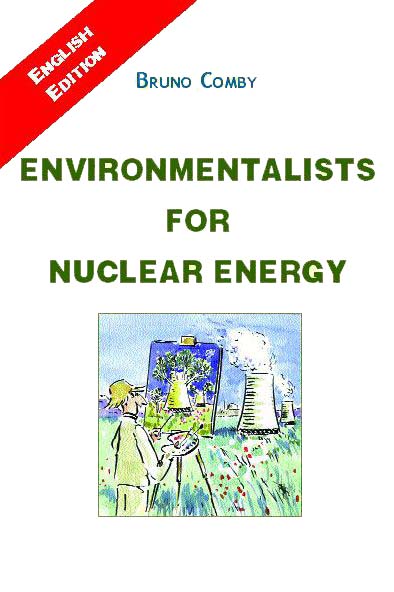
Presentation
of this book -
Author
of this book -
Order
this book
Copyright notice : you are
authorized (and encouraged) to distribute, translate in other
languages and/or publish the text of this preface by James Lovelock
freely, in paper or electronic form. You are authorized to send it to
the media for publication, with the authorization to be published,
under the condition that : 1/ it is republished or transmitted as is,
without any modification 2/ you send a copy of the published
article(s) to: efn[at]ecolo.org 3/ translation(s) be sent to
EFN for reviewal before publication, such translation(s) may be
posted on EFN's web site and/or to EFN's mailing lists.
Bruno
Comby, EFN founder and
president (http://www.ecolo.org
), is a well known Euorpean environmentalist, the author of 10 books
published in 15 languages on ecology and energy, including the
bestseller "Environmentalists
For Nuclear Energy"
(published by TNR
Editions), a graduate of
the Ecole Polytechnique in France, and holds a postgraduate
qualification as nuclear physicist from the Superior National
University of Advanced Technology in Paris (ENSTA).


http://www.ecolo.org
EFN - For complete and
straightforward information on energy and the
environment
To subscribe (or unsubscribe) to EFN's mailing list, go to EFN's
web site : http://www.ecolo.org
and click on "mailing list".
You may, with their approval, freely subscribe to the mailing list
all those among your friends who would like to be informed about
energy, the environment, and EFN's activities. To do this, just type
their e-mail address above, and click the "Subscribe" button (with
their approval).
To subscribe to our mailing list, the only condition is to share
our point of view and to type in your e-mail in the box above. You
will then be informed automatically of EFN's activities. This
subscription is entirely GRATIS. EFN is a not-for-profit
organization. It does not place any commercial advertisements on it's
web site, and does not sell it's mailing lists to anybody. To help
the EFN continue its activities, inform the public, and maintain this
FREE service, you can subscribe
or make
a donation to the association. Your donations are tax-deductible
in France. For subscriptions and donations intended for EFN-USA,
click
here (for our American readers and US citizens, donations in US$,
EFN-USA is a 501(c)(3) tax-exempt not-for-profit corporation). For
donations in Japanese Yens (for our Japanese readers), click
here.
©
EFN, all rights reserved - Unless
specifically mentioned otherwise, reproduction, use or distribution
of these information, texts or images, without EFN's prior written
approval, is forbidden


 Photo
of the Chernobyl reactor building after the accident
(1986)
Photo
of the Chernobyl reactor building after the accident
(1986)


